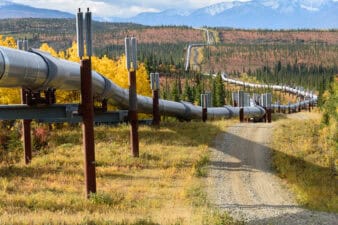The latest oil price collapse will devastate Canada’s energy patch. While some pundits believe prices will rebound, any rally appears to be some way off with worse ahead for crude.
Oil prices have weakened significantly in recent days to see West Texas Intermediate (WTI) trading at US$20 per barrel. There is every indication that oil will tumble lower to see the North American benchmark hit US$10 a barrel. That will be a disaster for Canada’s oil patch, especially considering that Canadian oil benchmarks trade at a discount to WTI.
Operating at a loss
The heavy oil benchmark Western Canadian Select (WCS) has crashed to a record low of US$4.58 per barrel. It now costs more to extract bitumen and ship it to refining markets than it is worth. This is a significant blow for Canadian oil companies, particularly those operating in the oil sands producing bitumen and other forms of heavy crude.
Canada’s third-largest oil sands operator Cenovus (TSX:CVE)(NYSE:CVE) reported that it cost $8.15 to extract one barrel of heavy crude from its oil sands operations. Transportation and blending costs were $8.94 per barrel of bitumen pumped. This illustrates it is costing Cenovus more to extract and transport a barrel of bitumen than it is worth. For a company, where 78% of its hydrocarbon output is comprised of bitumen and other forms of heavy oil, that will have a sharp impact on its earnings.
Current WCS pricing makes it inevitable Canada’s heavy oil producers will be forced to shutter operations. Such low oil prices, particularly for WCS, mean that much of the oil being pumped is going into storage rather than being shipped to U.S. refineries.
Industry analysts estimate that Canada’s 40 million barrels of oil storage is close to capacity. When there is no capacity left, which could occur by mid-April, the price of WCS and other Canadian crude benchmark prices will fall even lower. At such a difficult time, preserving cash flow and balance sheets becomes the most important goal. That will force further production cuts and the shuttering of a considerable portion of Canada’s oil sands operations.
This will have a marked impact on the earnings of oil sands companies and heavy oil producers. Oil producers won’t even be able to boost production to generate additional revenue to make up for the steep decline in cash flow caused by the latest oil price collapse. It will eventually trigger a new round of bankruptcies, because even asset sales won’t generate enough capital to meet financial obligations and debt repayments. In such an environment, many oil sands assets will be essentially worthless.
Rising risk
Heavily indebted higher-cost producers like Cenovus and Baytex (TSX:BTE)(NYSE:BTE) are particularly vulnerable to the latest crisis facing Canada’s energy patch. Cenovus finished 2019 with $6.7 billion in long-term debt and a further $1.7 billion in long-term lease liabilities. The driller is under considerable pressure to boost free cash flow to reduce debt.
Baytex, which is a far smaller company, has a massive $1.9 billion in net debt. It also has some near-term debt maturities totalling US$400 million falling due in 2024. That highlights the urgency with which Baytex needs to generate free cash flow and reduce debt.
Baytex has already suspended 3,500 barrels daily of loss-making heavy oil production and will be forced to shut in further heavy oil operations. That will have a sharp impact on earnings, because 32% of Baytex’s 2019 hydrocarbon output was heavy crude.
Those operational shut-ins saw Baytex revise its 2020 production estimate downward to an average of 85,000 to 89,000 barrels daily. Shuttering further operations will cause Baytex’s production and revenue to fall, potentially forcing it to sell assets at fire-sale prices to meet its financial obligations.
Looking ahead
The outlook for the oil patch is extremely poor. The fallout from the coronavirus pandemic and the oil price war will weigh on energy prices for months to come. There is also a looming demand shock, which could send oil even lower, with some pundits predicting that WTI will plunge to US$10 per barrel. This will not only force drillers to shutter production but trigger a new round of bankruptcies in the energy patch.






